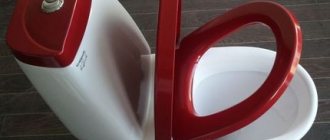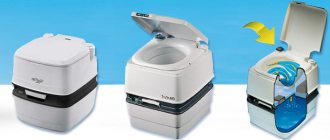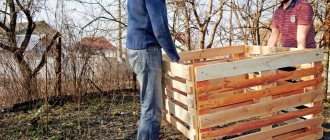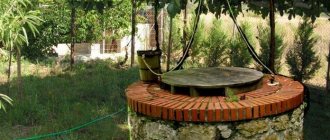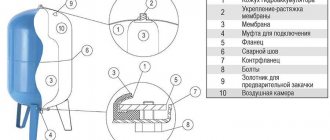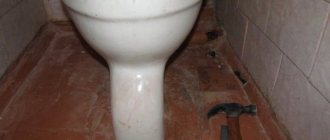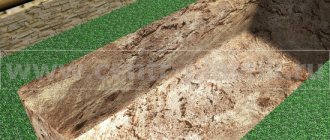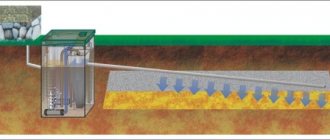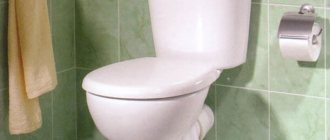For normal operation, a modern dry toilet requires special consumables - flushing fluids and preparations for breaking down waste from users, as well as special toilet paper. Without special liquid, such a toilet will turn into an ordinary chamber pot, poisoning the entire house with a stench.
How to avoid such a situation? Yes, it’s very simple: read our review of liquids for dry toilets, buy the necessary drugs and use them in a timely manner. By following these recommendations, you will receive the usual level of comfort even if there is no connection to the sewerage system or central water supply.
Liquid for dry toilet
Liquid for composting toilets - what is it?
Self-contained latrines consist of two tanks:
- Upper
(reception). It has a built-in toilet and a container of water for flushing. An electric motor or hand pump is responsible for pumping up pressure. - Nizhny
. It contains a receptacle for flushed waste. Solid fractions remain in the lower reservoir, where they decompose under the influence of biological products.
Liquid for a composting toilet helps process solid waste into a homogeneous, odorless mass. It works for 10-14 days. After this, the toilet must be cleaned. Liquid for dry toilets performs the following functions:
- Eliminates unpleasant odors.
- Prevents the spread of germs and bacteria.
- Speeds up the waste disposal process.
Depending on the type of liquid used for a bio-toilet for a summer residence, the contents of the storage tank are either disposed of in existing centralized drainage systems or directly into the soil. The frequency of maintenance of the dry closet of the lower section is once every 5-8 days, the upper section is once every 10-15 days. The cabins do not require connection to the water supply. They can be installed anywhere.
Characteristics of an organic reagent
The properties of such a product are manifested in such a way that the living bacteria that are part of it and produce special enzymes destroy waste. Typically, the reagent consists of a mixture rich in natural beneficial microorganisms and enzymes that correspond to them.
The organic reagent for dry toilets is peat. The principle of operation is that a small amount of peat mixture is placed in the lower waste tank, creating an aerobic environment that promotes waste decomposition. The composition of such a mixture includes microorganisms that process waste; leavening agents that increase air access; special absorbers of unpleasant odors. With a dosed supply of peat mixture, waste is converted into environmentally friendly compost.
Liquid for dry toilet - types
It is important to know what kind of liquid is poured into the dry closet. Only special formulations can kill all harmful bacteria, thereby eliminating the formation of unwanted odors. Liquids for composting toilets process human waste and used toilet paper into a mass of uniform composition and color. Nowadays, several generations of such products are presented in the markets - formaldehyde, ammonium, biological.
Formaldehyde liquids for dry toilets
The chemical composition of formaldehyde-based chemical toilet liquid is very strong. It breaks down any organic matter using the phenomenon of molecular melting. Formaldehydes act with excellent efficiency, but after such treatment the wastewater becomes toxic. Their disposal involves only one thing - removal outside the site. Formaldehyde sanitary liquid for dry toilets has the only advantage - the combination of low price with ideal resistance to various cleaning and deodorizing compounds.
Ammonium liquids for dry toilets
Modern toilet liquid for dry toilets based on ammonium and nitrogen compounds decomposes fecal waste due to the fermentation of organic matter, enhanced by chemicals. It is very effective, but only works in an environment with a limited amount of oxygen. Often such liquids are poured into portable devices. Waste can be disposed of in compost. This product completely decomposes within seven days. It is relevant for summer cottages and portable cabins, but is unacceptable for public closets due to the long period of waste recycling.
Biological fluids for dry toilets
The most environmentally friendly liquids for dry toilets are biological.
- They are an ensemble of living bacteria.
- Effluent is processed using anaerobic fermentation.
- Non-toxic to humans and the environment.
Biological fluids for composting toilets transform waste into effective fertilizer. The contents of the lower tank are dumped into a compost pit and used after ripening. Bioliquids do not tolerate contact with chemicals, so users must purchase specific deodorizing compounds for the upper reservoir. Chlorine-containing preparations kill the activity of bacteria, and the reaction of waste breakdown stops.
Which one is better to buy
The comfort and cleanliness of bioclosets directly depends on the correct care of them. Currently, manufacturers present a huge range of certified products, both already proven and new products, differing in consistency, composition, price and purpose. The shelves contain fillers of both Russian and foreign origin. Which company is better, everyone chooses for himself, taking into account a review of popular models, expert advice, and how much it costs.
Everyone's selection criteria are different. What should you pay special attention to in order to avoid mistakes when choosing? Where to buy and what products to choose depends, first of all, on the method of disposal. The following types of compositions are available to choose from:
- Biological. The most environmentally friendly composition that allows you to transform waste into fertilizers and use them for their intended purpose. It’s difficult to call liquids inexpensive, but you can pay a significant amount for such a product.
- Ammonium. They are classified as effective, but require a limited amount of oxygen. They are often used in portable designs. Waste disposal is carried out in a compost pit. Can be purchased for 250 rubles and used for three months.
- Formaldehyde. They process waste quickly and efficiently, but are quite toxic. They are not recommended for use in suburban areas, since they must be drained into the central sewer system, which may not exist. The price is reasonable - from 300 rubles per 1 liter. One unit usually lasts for four months.
According to buyers, the rating of this product category is topped by Aqua kem. Its products enjoy well-deserved popularity due to the presence of a quality certificate. The range of applications is wide: for preservation, deodorization, as a bioactivator. It can be poured into both tanks and is available in a variety of scents, including the scent of watermelon.
Preference is given to the Aqua kem blue reagent - a special deodorizing gel intended for pouring into the bottom tank of a dry closet. Thanks to him, the design contains a delicate and fresh aroma. The composition has the following qualities:
- neutralizes unpleasant “odors”;
- minimizes the appearance of fungi and bacteria;
- makes drains clean;
- ensures perfect cleanliness thanks to disinfecting components;
- dissolves solid particles to a liquid consistency;
- smells good;
- efficiency;
- ease of use.
The product can be ordered online in an online store, or visit a specialized retail outlet. The average price of products is from 1500 rubles.
What kind of liquid is needed for a dry toilet?
Proper operation of a dry closet involves the use of special means. According to their purpose, they are divided into two main groups:
- Liquids for upper tanks are flushing and deodorizing.
- Liquids for lower tanks are dissolving, splitting.
Liquids for the lower tank are often green or blue in color and should never be poured into the upper tank. For this purpose, there is a liquid for the toilet cistern with deodorizing properties - pink. A convenient and win-win option is to purchase disintegrators and antiseptics from one manufacturer so that the recycling process does not slow down. Then their action will not work through mutual exclusion, they will complement each other.
Fluid for composting toilet for the upper tank
It is important to know what liquid to pour into the upper tank of the dry closet. The drain tank is filled with ready-made compounds or water, which should wash away waste products. In the second case, some additives are poured into it:
- Deodorizing substances
. They eliminate unpleasant odors and inhibit the development of bacteria. - Cleaning agents
. They whiten the surface of the toilet and help rid it of urinary stones and limescale. - Antifreeze
is a winter liquid. The product lowers the freezing point of water in the upper tank. This liquid for the dry closet tank will help maintain the functionality of the system even in frosts down to -45°C.
Fluid for composting toilet for the lower tank
The dissolving liquid for the bottom tank of the dry closet must decompose the solid waste fraction. Such compositions have an active chemical and biological effect. They process or dissolve the waste, finally eliminating the odor and reducing the solid contents of the sump in volume. In addition, deodorizing substances and antifreeze can be added to the lower reservoir, which make it possible to operate the toilet in winter.
Auxiliary products for dry toilets
In addition to the basic liquids, from time to time, cleaning, deodorizing and anti-freezing additives are introduced into the upper and lower chambers of the toilet. A good example of such drugs are the following drugs:
Deodorizing liquid for composting toilet Biola
Concentrate based on naturally degradable components. Does not harm the ecology of the site and human health. Removes unpleasant odors in a very short time. Therefore, Biola is used not only by owners of dry closets, but also by owners of country houses with amenities in the yard.
For a standard dry toilet with a sump volume of up to 50 liters, a one-time injection of 100 grams of the drug is sufficient, which is dissolved in 3 liters of water and poured into the upper tank or directly into the lower container. The procedure is repeated if necessary.
- Ingredients: surfactant complex, aromatic additive, targeted additives, dye, water
- Does not contain environmentally harmful substances: phosphates, phenols, acids, alkalis
- The product is available in liter bottles
- Price of the drug – from 400 rubles
Fermentation accelerator for composting toilets
BIOFORCE BioToilet Comfort is a biologically active drug that increases the concentration of anaerobic and aerobic bacteria in the lower chamber of the dry closet. Accelerates the process of fermentation and breakdown of solid fractions of organic waste. Essentially, this drug cleans the lower chamber of solid deposits, separating them into liquid and gas. Recommended for use in case of increased load on the dry closet (unexpected arrival of guests, etc.).
- The packaging of BioToilet Comfort contains 20 sachets, each of which is designed for a volume of up to 20 liters.
- The bags are dumped into the lower chamber or dissolved in the drain tank
- The cost of packaging is 2200 rubles.
Thetford Bathroom Cleaner
a disinfectant for toilets and septic tanks, which has an antistatic effect and whitens treated surfaces. Helps maintain hygiene in areas where the dry closet is used. Unlike chlorine-containing and acid-based products, Bathroom Cleaner does not harm the seals and polymer body of the dry closet.
- Available in half-liter bottles with sprayer
- Cost – from 350 rubles
Which liquid to choose for a dry toilet?
When deciding how to choose a liquid for a dry closet, it is important to know that consumables are selected depending on what type of closet design is installed:
- Ammonium
is suitable for closed toilets and ensures rotting of the waste material. - Formaldehyde synthesis
is used where there is sewage, since the formaldehyde used is a toxic poison. It perfectly decomposes waste and prevents pipe blockages. - Biosynthesis
is used in dachas and in the private sector, when waste is planned to be used in the form of fertilizers.
Features of biological products
Any biochemical product for dry toilets and cesspools contains various bacteria, which, once in the mass of wastewater, help displace putrefactive microflora and help decompose solid inclusions, as well as the formation of sludge. The latter is usually used as an environmentally friendly organic fertilizer.
Biological drugs can be in the form of solutions, tablets or powder, which are diluted in water in advance. They also have disadvantages, including sensitivity to environmental factors. Such microflora can only exist at temperatures from +5 to +35 degrees. In addition, when using a product for dry toilets and cesspools, you should carefully select detergents for dishwashers and washing machines, disinfectants and cleaning compounds for plumbing. Some of them lead to the destruction of beneficial bacteria if they get into the sewer or septic tank.
Liquid for composting toilet - rating
There are a large number of liquids for dry toilets on the market; when purchasing, you should pay attention to products from trusted manufacturers:
- Liquid for dry toilet ThetFord
. The Dutch manufacturer offers a wide range of effective consumables. Liquids for the lower tank Aqua Kem Green, B-Fresh Green, Aqua Kem Blue with aromas of citrus, pine needles, lavender slow down the growth of bacteria and the production of gases, convert waste, and are environmentally friendly. The green mixture is used if the waste material is poured into compost, the blue mixture if it is poured into the sewer. Pink consumables for the upper tank Aqua Rinse, B-Fresh Rinse form a film that protects it from the formation of plaque and prevents water blooms. - Septicsol
. The Canadian manufacturer offers high-quality liquids for the lower tank Septicsol-L. They can be used either separately or together with flushing agents for the Septicsol-R upper tank. The products will help get rid of the repulsive odor and process waste into an environmentally friendly substance that can be used as fertilizer. - Biola
. A domestic brand producing universal sanitary liquid. The biodegradable product is used in both the lower and upper tanks; it effectively breaks down waste, disinfects containers, and saturates the bathroom with aroma. The drug is environmentally friendly, can be used in residential premises, outdoors, and does not lose effectiveness at low temperatures.
Upper section liquids
The upper part is filled with products that are diluted with water. To destroy microorganisms and unpleasant odors, use deodorizing liquids for dry toilets:
- BIO WC-45 is an effective product for dry toilets, which can be used when operating local sewage systems in outdoor conditions. This liquid helps drain waste at temperatures from 0 to minus 50 degrees. The dose of this drug, which is mixed into water, depends directly on the temperature. For example, at -15 C, only 350 g of BIO WC-45 is needed for 15 liters of water. If the frost outside has dropped to a critical temperature of -50 degrees, then for the same amount of water you need to add 550-650 g of liquid for the dry closet.
- Composition of BioToilet W from the popular manufacturer of biological products "BIOFORCE". These drugs are used as an additive to plain water, using a ratio of 1 capful of product per 10 liters. The liquid allows you to wash both waste and unpleasant aroma into the lower compartment, creating a slippery shell on the surface of the dry closet. In the lower zone, the product helps the activity of bacteria that break down feces. This drug is completely harmless to the environment.
- Aqua Kem Rinse - the product aromatizes sewer water, maintaining freshness in the room, reduces the activity of microorganisms that cause gas formation. In addition, the remnants of this composition create a special film on the inner surface, which makes it easier to drain the waste. Reviews of this liquid prove that this product works great both in home stationary toilets and in mobile restrooms.
DIY liquid for dry toilet
Compositions for the bathroom cost a lot; in extreme cases, you can make them yourself. For this you will need:
- Vinegar
– eliminates unpleasant stench and has an antibacterial effect. - Salt
– absorbs dirt. - Essential oil
– gives a deodorizing effect. - Starch
is a binding component.
How to prepare liquid for a composting toilet yourself:
- Mix 1 part salt and 3 parts starch.
- Pour 100 ml of water for every 100 g of dry mixture.
- Mix the composition until a homogeneous mass is formed.
- Heat the mixture over heat, stirring until it thickens.
- After the mixture has sizzled, it needs to be heated for another half a minute.
- After cooling, add vinegar to the antiseptic - 8 ml for every 100 g of mixture and essential oil - 3 drops for every 100 g of mixture.
- The composition for the tank is ready, you can pour liquid soap into it, it will increase its cleaning properties. The validity period of a homemade consumable is 1-2 weeks. In terms of effectiveness, the composition is inferior to professional products, but in case of its absence it will do its job well.
Preparations with ammonium
Products used to decompose fecal matter containing ammonium are considered high-quality. They act quickly and effectively, and remarkably eliminate unpleasant odors. The disadvantage of this product for cesspools is its greater sensitivity to environmental aggressiveness, as well as poor interaction with various household chemicals. For example, if after a shower or washing soap solutions get into the drains, the ability of such a product to liquefy waste is reduced several times. It is worth noting another important point: the effect of ammonium on the environment has not been fully studied.
Liquid consumption for dry toilet
When using liquid, follow the recommendations on the packaging. The average consumption of sanitary compounds is as follows:
- Liquid for dry toilet, green or blue (in the lower tank) – 70-150 ml.
- Liquid for the upper tank is pink – 75-100 ml.
Whether the dry closet is used often or rarely does not matter, the liquid loses its properties after 1-2 weeks, so it needs to be systematically renewed - in the upper tank every 10-15 days, in the lower tank - every 5-10 days. According to information from manufacturers, a one and a half liter bottle of sanitary liquid lasts on average three months for an ordinary family of three people.
Types of consumables
Buying a portable restroom will allow you to enjoy all the benefits of civilization even in the country. However, various chemicals are required for its normal functioning.
It is divided into:
- Toilet liquids
- Disintegrators in powder form
- Pills
- Cleaning products
Their range is quite wide, but before purchasing this or that product, you should find out their methods of use.
Products from Thetford company
Let's start with liquids for recycling. They are needed for the lower tank and help eliminate unpleasant odors, as well as quickly dissolve waste. Their use allows you to avoid the accumulation of gases and clogging of the dry closet. Thanks to them, a portable toilet can match the convenience and hygiene of a regular home toilet.
Among the most popular are:
- AquaKemBlue from Thetford
- Biolan (locally produced)
The first product has a pleasant smell and a high concentration of substances, which indicates its cost-effectiveness. This drug is biological and safe for people.
Powder disintegrators are also presented by this manufacturer. They have similar properties and are convenient to use. They are easier to dose.
Liquids for the upper tank of a dry closet are added directly to the water. They appeared on the market quite recently, but have managed to establish themselves as excellent hygiene products. They are produced by the same Canadian manufacturer. Thanks to the use of these compositions, a protective film is formed on the surface of the dry closet, which allows you to most effectively maintain hygiene standards.
CassetteTank Cleaner
Cleaning products from the Canadian manufacturer are represented by the CassetteTank Cleaner series. These are products with a bleaching effect that can not only keep the surface of equipment clean, but also give it antistatic characteristics. They are highly concentrated, which ensures an ideal surface for a long time.
To care for equipment, silicone lubricants are also produced that protect surfaces from various types of influence. They are used for any materials and extend their service life.
Another type of chemical toilet product is tablets. They are a lime-based concentrate and are used both in autonomous sewage systems and in cesspools.
Finally, for maximum hygiene of the dry closet, you will need special paper. It is produced under the AguaSoft brand. Its distinctive properties are complete and rapid dissolution in the receiving tank, which avoids clogging of the dry closet.
Conclusion
Having considered the types and brands of various consumables for a portable restroom, you can understand that only with the right choice will it function normally. Which manufacturer to choose depends on your financial capabilities.
But, undoubtedly, all the advantages are on the side of foreign companies. They have extensive experience in this field and their products are unrivaled in the Russian markets. It is the best and will allow you to keep your dry closet in perfect shape.
Source
How to fill a dry closet with liquid?
It is important to know where to pour sanitary products for the bathroom. Rules for using liquid for a composting toilet:
- The upper flush tank has a hole for filling water and deodorizing liquid. You need to unscrew the toilet cap, pour the pink preparation and water into the hole.
- Green or blue liquid is poured directly into the lower reservoir. You also need to add 2 liters of water to dilute the product.
Rating of the best brands based on user reviews
Liquids from Russian and foreign manufacturers are available for sale.
Thetford
The leader in all respects is the Thetford brand made in the Netherlands. The company sells liquids for the upper (bottles with pink caps) and lower (bottles with green and blue caps) compartments of dry closets.
Liquids for Thetford composting toilets are made in the Netherlands
Products with blue lids are made from formaldehyde; waste processed with them can only be poured down the drain. In bottles with green caps, the composition includes bacteria that destroy unpleasant odors and turn waste into a safe liquid. Users note the advantages of the brand:
- no smell in the bowl;
- excellent performance at temperatures close to zero;
- pleasant mild aroma of deodorizing liquid;
- Ease of use - childproof lid.
Where to pour liquid from the dry closet at the dacha?
The design is very simple to use:
- After using the toilet, you need to open the valve and press the flush pump 2-3 times.
- When the lower tank is full, you need to disconnect the top from the bottom and take the lower canister to the waste collection point.
- The drain pipe is turned and the contents are poured out carefully, without splashing.
The lower tank must be rinsed and filled with water with the addition of a disintegrating agent. After this, the structure is again ready for use. Where to pour liquids:
- If green liquid is used for a dry closet, the contents of the storage tank can be poured into the soil without fear of harming the environment. In air, such a substance becomes absolutely safe.
- Waste treated with ammonium liquid can be disposed of in a compost heap.
- If a formaldehyde dry closet is used, the instructions for using liquids prohibit the use of the contents of the storage tank as fertilizer; it can only be sent to the central sewer system.
Features of chemical cleaning
A chemical product for dry closets and cesspools can operate at absolutely any temperature, which makes it possible to reduce the level of requirements for the operation of such products.
If chemicals are used, then it does not matter what household chemicals are used. In addition, such products do not care about the quality of water.
Chemicals have the following disadvantages:
- there is a risk of toxic substances getting into the soil;
- aggressiveness of the composition towards metal sewer pipes and other elements of the system.
Chemicals are best used for tanks and pipes made of polymer materials that are resistant to such influences.
How to replace liquid for a composting toilet?
A liquid bathroom is not a cheap pleasure; it will require deodorizing toilet liquid and disintegrating compounds, which you need to constantly buy. A cheap alternative is powder closet, which is available to almost everyone. Its main difference is that the waste container is masked with some kind of powder: dry soil, sawdust, ash; in a modern dry closet, peat is actively used. This design does not pollute the environment and does not require water to operate. The result is an effective natural fertilizer.
Liquid for septic tanks and cesspools - purpose and main properties
Liquid for dry toilets is a special chemical composition, the components of which kill specific odors, destroy pathogenic microflora, and decompose solid residues.
Thanks to the use of the product, gas formation, silting and rotting of the contents of tanks are reduced. Liquid for septic tanks and cesspools As a rule, this is a concentrate that contains means for preserving and disinfecting human waste products. Effective for all types of cesspools, dry closets and septic tanks. Forms a film on the surface of the tank, which reduces silting. The components of the composition do not cause corrosion of the materials that make up the waste tank, and are also safe for the environment.
Leading experts on the operation of latrines of this type recommend purchasing and using liquid for dry toilets. It is important to follow the instructions and follow the rules for using the product:
- All manipulations with the concentrate must be performed with rubber gloves. If the product gets on exposed areas of the body, it must be washed off with water. If your eyes are affected, consult a doctor;
- Store in places away from the sun. Keep children and pets away. Ensure the temperature ranges from -15 to +25 degrees Celsius;
- Dilute according to the instructions, no more than 550 milliliters per 5 liters of water for a 100-liter tank.
Buy or make your own?
There are also many recipes for making chemical liquids for a home dry closet - all of them will ultimately be cheaper than the products sold in stores. However, one point should be taken into account - the manufacturer always provides a guarantee for its products. And all substances that go on sale are subject to standardization, undergo many different tests and are subject to mandatory certification. Even if in one case out of a hundred a substance shows itself negatively and cannot meet at least one point declared by the manufacturer, such a substance is not allowed in display cases.
In addition, manufacturers provide the following properties:
- Prevent gas formation.
- Grinding of coarse waste elements.
- Neutrality to metal, plastic, rubber.
- Does not freeze and does not lose its beneficial properties in the cold.
- Decomposes waste products up to 90%.
When independently experimenting with various chemicals, all risks fall on the experimenter. It is good if the recycled materials are disposed of in a centralized sewer system. If the processed masses are intended to fertilize a vegetable garden or orchard, then many questions arise regarding the purity of products grown with such fertilizer.
In most cases, dry toilets are used as a temporary solution or in summer cottages with seasonal visits, for a small amount of waste. And purchasing, for example, eco-liquid for one season will not pose a serious threat to the budget. That is why the likelihood of high costs for splitters is excluded in principle. For a house with permanent residents, it is more advisable to install a septic tank or at least a filtration well, if conditions permit.
Sanitary fluid intended for dry toilets is represented by both expensive products, characterized by quality and environmental friendliness, and cheap formaldehyde solutions, which are not intended for disposal into the ground due to their toxicity. All products are interchangeable and a replacement for campagreen liquid for dry toilets, produced by American specialists, can be domestic Biola, which is much cheaper, not much inferior in quality and has positive reviews.
There is also the option of making splitters yourself, but before you replace the chemical toilet liquid from the store with a substance of your own production, you should make sure that it is safe. And if recycled waste is used as fertilizer in the garden, then you should weigh the possible risks three times before you start saving in this way.
Universal product for all types of drains
A universal product for all types of waste water.
Concentrated liquid for dry closets has increased efficiency due to the high content of active components. This chemical is intended for the care of cesspools, bio-toilet systems and septic tanks of all types. Helps keep storage tanks and drains in the most favorable form, reduces the toxic impact of waste on the environment.
One of the main problems in the operation of dry closets and septic tanks is the development of pathogenic microflora. The contents of storage tanks provide a favorable environment for the proliferation of salmonella, other dangerous microbes, as well as insect larvae and fungal mycelia. The concentrate destroys all types of microorganisms, making the toilet safe for health.
It is profitable to buy and use liquid for a dry toilet from the point of view of reducing waste disposal costs. The composition promotes the decomposition of waste to a uniform consistency of a minimum volume, which makes it possible to pump out the contents of a septic tank or cesspool less frequently. The concentrate does not contain chlorine, formaldehyde and other harmful chemicals, and is safe for soil, storage tank materials and wastewater. Prevents the formation of gases and destroys specific odors.
If you are interested in checking out quality products on the topic of this article, we suggest you follow the link
View all products in the category
CONTENT
- How difficult is a DIY peat toilet?
- Installing a composting toilet at your dacha with your own hands: what is needed for this?
- Do-it-yourself dry toilet for the home: video and instructions
- About consumables: how to make liquid for dry toilets with your own hands?
The need for such a facility in the country as a toilet cannot be underestimated. Unfortunately, not everyone has the financial and other opportunities to arrange a warm toilet indoors, so those who arrange it outside try to do everything possible to create a “place for privacy”:
- convenient to use;
- inexpensive to implement;
- easy to maintain.
Based on the combination of these factors, peat dry closets are confidently becoming the leader among the preferences of summer residents. This is a simple and environmentally friendly object that you can easily create yourself, even without the proper skills. In addition to the simplicity of the design, it “came into fashion” due to the possibility of creating organic fertilizer, which is useful on the farm, it is easy to transport, and the problem of toilet waste is easily solved.
This article will provide you with information on how to create a dry closet with your own hands and what you will need for this.
